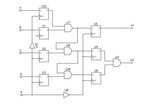farabi2017
Newbie level 3
For the circuit shown below, the timing parameters of its components are: tAND = 0.4ns, tbuf = 0.2ns, tsetup = 0.2ns, thold = 0.2ns, and tclk→Q = 0.4ns. When answering the following questions, you need identify the path used in your computation.

1.1) Calculate its maximum clock frequency.
1.2) Calculate its clock to output delay.
1.3) Calculate its external setup time.
1.4) Calculate its external hold time.
1.5) Show how you can improve the circuit clock frequency to 2.5GHz. Note that the modified circuit should keep the same function and cannot have other timing violations.

1.1) Calculate its maximum clock frequency.
1.2) Calculate its clock to output delay.
1.3) Calculate its external setup time.
1.4) Calculate its external hold time.
1.5) Show how you can improve the circuit clock frequency to 2.5GHz. Note that the modified circuit should keep the same function and cannot have other timing violations.